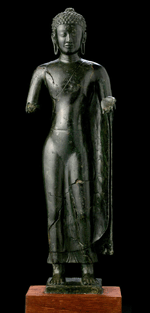There are two types of Buddha statues in Khmer art: the unadorned
and the adorned Buddha. This figure is an unadorned Buddha (with
simple monastic robes). His figure is specifically presented by
distinctive characteristics called
‘Sambhokaya’.
The most interesting among them are: the cranial protuberance
from the head of Buddha (usnisa) representing supreme knowledge,
a tuft hair between the eyebrows (urna), long earlobes, curly
hair, disks (cakra) on the palm and soles and monastic robes.
The draping style of the monastic robes in our
time is indeed the same as that of the Buddha. There are three
types of monastic robes: under garment (sampot ngout), the robe
that covers the shoulder (sometimes the shoulders) uttarasanga
called (cheipor), the robe covering the lower part of the body
from the hips antaravasaka called (sbang). The uttarasanga can
be worn in two ways: the left shoulder is bare in the ‘krang’
style and the both shoulders are covered in the ‘khlum’
style.
This Buddha is wearing the robe in the krang
style, with two monastic robes: the cheipor and the sbang, which
descends to the lower ankles. The gesture of the left hand represented
by the index finger touching the thumb, is called the ‘Vitarka
mudra’ that means reflection or teaching.
The squared shoulders, large jaws, muscled chest,
extended abdomen, semi-closed eyes, three folds of the neck, and
face with semi-smiling expression all highlight naturalism.
It appears the monastic robes of this Buddha
are very thin because of the shapes of the legs and torso can
be clearly discerned. The ancient Khmer artists strove to evoke
the luminosity of the Buddha’s body through the transparent
robes.


